Media | Articles
Epic Engines: How the V-12 became Ferrari’s heart and soul
In the summer of 1945, only a few months after Allied bombers stopped punishing Italy for its WWII transgressions, Enzo Ferrari summoned his trusted colleague Gioacchino Colombo to Maranello for consultations. Though postwar racing rules had not yet been announced, Ferrari was anxious to build his own cars to compete. Anticipating a 4.5-liter displacement for naturally aspirated engines and a 1.5-liter limit for supercharged powerplants, Ferrari sought the advice of one of Italy’s foremost engine designers.
Asked how he’d construct a new 1500-cc engine, Colombo mentioned ERA’s promising six-cylinder and eights under development at Alfa Romeo and Maserati before proclaiming, “In my view, you should build a 12-cylinder!”
The usually aloof Ferrari lit up like a Roman candle. Turns out the 47-year-old racing don had admired V-12s for years after hearing primo piloto Antonio Ascari rev the engine in his 1916 Packard racer and seeing WWI American military officers cruise Italy in their majestic Packard Twin Sixes. He and Colombo immediately began conceptualizing the Scuderia’s first V-12, the engine destined to become the Prancing Horse’s heart and soul.
Ferrari’s timing was perfect because Colombo had been laid off by Alfa Romeo due to Italy’s postwar economic turmoil. Though the 42-year-old lacked a formal technical education, he had served a lengthy apprenticeship designing engines, including V-12s, under Alfa Romeo’s brilliant Vittorio Jano. Colombo erected a drafting board in his Milan bedroom and in a few weeks completed sketches of both a new V-12 and the Ferrari 125 S sports-racer it would power. His guiding light was versatility in order to serve wide-ranging racing applications and eventual road use.
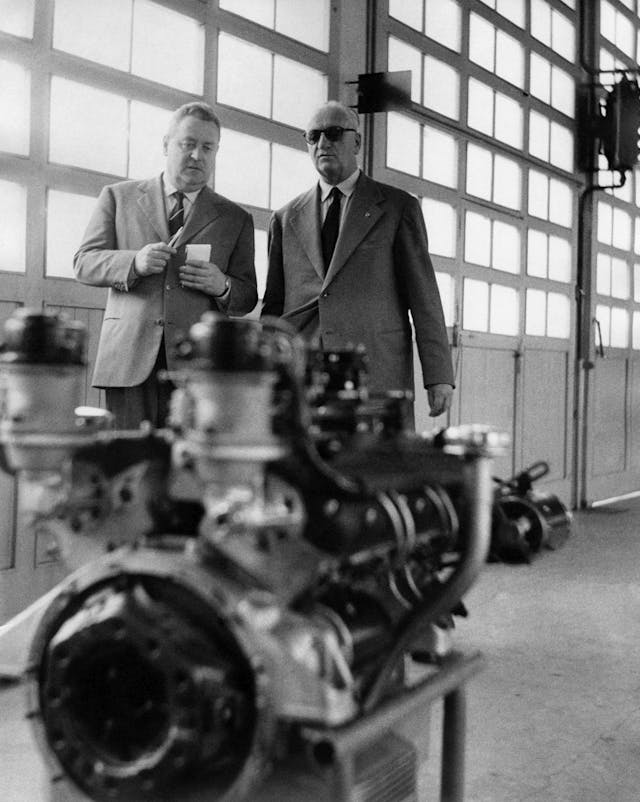
Packard’s 1916–23 Twin Six, the world’s first production V-12, made 88–90 horsepower from 6.9 liters. The beauty of a dozen cylinders in a V is perfect balance—freedom from the shake, rattle, and roll resulting from pistons starting and stopping at the ends of their strokes. (The same is true of an inline-six; a V-12 is simply two banks of six cylinders sharing a common crankshaft. A 60-degree angle between cylinder banks yields the even firing intervals necessary for smoothness.)
Marketplace
Buy and sell classics with confidence
Before we delve into Colombo’s V-12 design features, it’s essential to understand the operational details within every four-stroke engine. First, there’s an intake stroke when one valve opens to admit air (and usually fuel) to a cylinder while the piston moves top to bottom. Next is compression, with both valves closed and the piston rising in the cylinder, squeezing the mixture. Near the top of the piston’s travel, electricity sent across the spark plug’s gap serves as the match to light the bonfire inside one cylinder. Rising combustion pressure within the cylinder drives the piston back down, spinning the crankshaft and driving the wheels through the transmission. Then comes exhaust, when the piston again reverses direction, forcing burned gases out an open exhaust valve and into a pipe connected to the cylinder head through an exhaust manifold. Simply described, the four-stroke cycle is suck, squeeze, bang, blow.
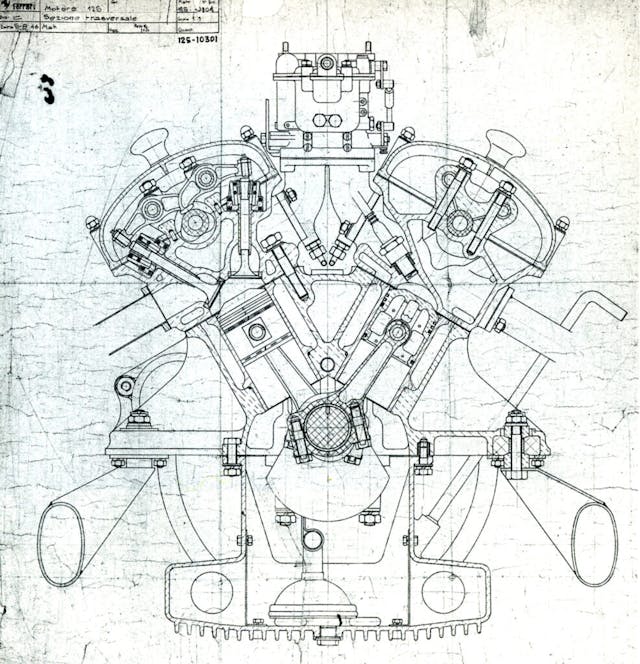
Given that each power stroke lasts the better part of 180 degrees, in a V-12, there are three overlapping power strokes at any given instance to run through all the cylinders in two turns of the crankshaft. As a result, output feels more like a continuous twist than discrete pulses. A V-12’s exhaust note can be whatever the designer desires, between a gentle purr and a coyote’s shriek.
V-12s do have several less sanguine design issues—added friction, heavier weight, higher cost, and their overall length. It goes without saying that when value and mpg are top priorities, carmakers steer clear of V-12s.

To minimize mass, Colombo chose aluminum over iron for the block and head castings. Italy had become an epicenter for bronze casting during the Renaissance back in the 14th century, specializing in statuary, equestrian monuments, cathedral doors, crucifixes, and even dishes.
Combining a 55.0-millimeter bore with a 52.5-millimeter stroke yielded the target 1.5-liter (1497-cc) piston displacement. Cast-iron cylinders wet by coolant were plugged securely into the bottom of the block with a shrink fit (achieved by heating the aluminum block to expand openings before inserting cold iron cylinders. Once the cylinders and block reach the same temperature, they’re securely locked together).
Bolts securing both the heads and the cylinders screwed into the block’s upper decks. Since the block’s side skirts ended at the crank centerline, the cast aluminum oil sump had ribs to radiate heat and to increase the engine’s overall stiffness. The crankshaft was machined from a single billet of alloy steel with seven main bearings and six throws spaced 60 degrees apart to provide even firing intervals. Connecting rods were forged steel.
One chain-driven overhead cam per bank opened two valves per cylinder through rocker arms. Locking screws touching the valve stems facilitated lash adjustment. (Lash is the small space in the valvetrain that allows each valve to seal tightly against its seat in the closed position.) The valves were splayed 60 degrees apart to straighten and streamline ports for maximum flow of air and fuel into each cylinder. A domed (aka hemispherical) combustion chamber topped each cylinder. Colombo screwed the spark plugs in from the intake side of the heads because the bore-center areas were blocked by the single overhead camshafts.
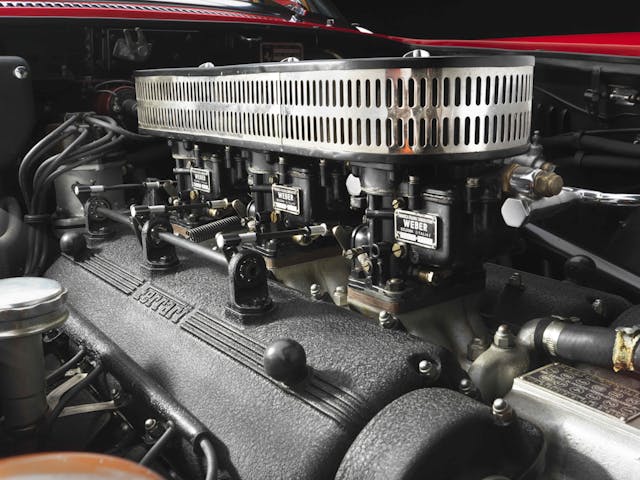
Three downdraft two-barrel Weber carburetors prepared ample amounts of fuel-and-air mixture. Twin Marelli magnetos driven off the tail end of each camshaft supplied the ignition energy. Initial output with a 7.5:1 compression ratio was 118 horsepower at 6800 rpm.
To provide a path to more power, Colombo gave his seminal V-12 three innovative features. The first was what’s known as an over-square bore/stroke ratio (a figure greater than one). The unusually short stroke diminished the pistons’ reciprocating motion, minimized the height of the block, and lowered the engine’s center of gravity. The relatively large bore in turn allowed larger valves (see end-view illustration), a boon to volumetric efficiency (fluid flow in and out of the cylinder head). The net result of Colombo’s over-square design was a rousing 7000 rpm available at the beginning of this V-12’s life. His second fundamental inspiration was 90-millimeter cylinder spacing to facilitate significantly larger bores and additional piston displacement with minimal changes to the overall design.

Colombo’s third special feature was the type of valve springs he incorporated. Instead of the spiral-wound coil springs that are now common practice, he used what was called a “hairpin” design (despite the fact they more closely resembled springs found in clothespins). He was inspired by air-cooled motorcycle engines, which used such a configuration for three key reasons:
The first is that the hairpin design was less susceptible to fatigue failure that, in the worst case, would destroy the engine when an out-of-control valve struck the top of a piston. Second, the hairpin design was a better means of exposing the valves to cooling air swirling over the top of the engine. Third, this design allowed shorter and lighter valve stems. Lighter valves are less susceptible to the fatigue failures common with racing cam lobes. In summary, the hairpin spring design was instrumental in helping Colombo’s V-12 withstand the rigors of racing. Two such springs were fitted to each intake and exhaust valve.

A paucity of intake ports was the most notable shortcoming in Colombo’s V-12. Since Ferrari hoped to add a Roots-type (twin interlocking lobes) supercharger, there were but three intake ports feeding six cylinders per bank. This arrangement made it more difficult to ram-tune naturally aspirated versions of the engine for competitive power at high rpm. (Ram tuning uses fluid-flow momentum to pack the maximum amount of air and fuel into each cylinder.)
With the ink barely dry on blueprints, Ferrari attacked the 1947 racing season with a two-seater dubbed 125 Spyder Corsa. The 125 code referred to the number of ccs per cylinder, spyder is Italian for roadster, and corsa is the boot country’s word for racing. Nine entries yielded two victories by Franco Cortese, two class wins by Tazio Nuvolari, one third, one fifth, and three DNFs. Adding a supercharger for its 125 Formula 1 single-seater yielded 230 horsepower and the Scuderia’s first grand prix victory. By October of ’47, Ferrari was ready to move up with a 1903-cc V-12 dubbed 159, followed by a 1995-cc 166 for the 1948 season.
The rising costs of fielding competitive cars in road races, endurance competitions, and F1 are what moved Ferrari to offer his cars to wealthy customers bent on enjoying them on the road.
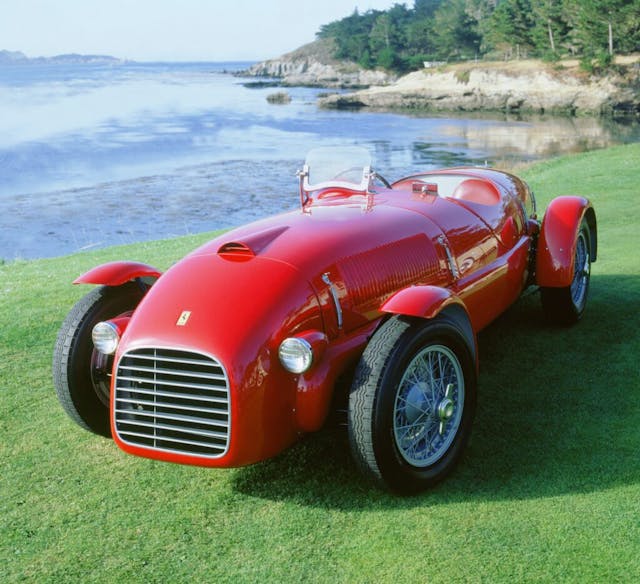
In a 1984 test of the first 1947 Ferrari 166 Spyder Corsa delivered to a private owner, Car and Driver clocked 0–60 in 13.1 seconds and estimated top speed at 121 mph. Weighing less than 1500 pounds, this red roadster rode on skinny 15-inch Michelin X radial tires. Respecting the vintage Ferrari’s rarity and fragility, C/D’s test driver used only 6000 rpm, so a run to 60 in under 10 seconds is probably within the Spyder Corsa’s reach.
Bolting on a two-stage supercharger in 1949 raised output to 280 horsepower, earning Ferrari five grand prix wins. In spite of the Scuderia’s early successes, Ferrari demanded more; Colombo fell out of favor and returned to Alfa Romeo in 1951. His successors? First Aurelio Lampredi, a former aircraft-engine designer, then four years later Colombo’s mentor Vittorio Jano, who continued development of Ferrari’s first V-12 another decade.
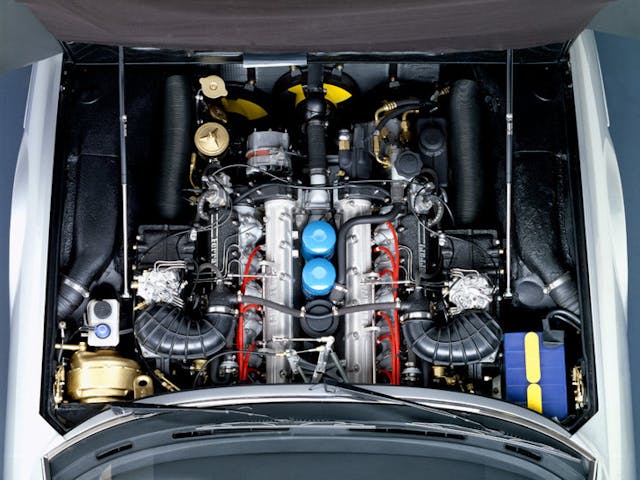
Colombo’s masterpiece grew from its original 1498 cc to a maximum 4943 cc in its final Ferrari 412i form. The 1957 250 Testa Rossa brought conventional coil-type valve springs, spark plugs relocated to the outer side of the heads, and one intake port per cylinder. These changes yielded 300 horsepower from 3.0 liters, enough prancing horsepower to win 10 World Sportscar races, including three Le Mans 24-hour events between 1958 and 1961. Ferrari 250 GTO sports cars that followed won the FIA’s over-2-liter championship from 1962 through 1964. In 1964, a 4.0-inch stretch of the block increased bore-center spacing from 90 millimeters to 94, allowing 4.0-liter and larger displacements.
Features proved on the track rapidly trickled down to Ferrari’s road cars. Dual overhead cams, still operating but two valves per cylinder, appeared on the 1967 Ferrari 275 GTB/4. The illustrious 1968 365 GTB/4 Daytona came with dry-sump lubrication. (Keeping oil well away from a frantically spinning crankshaft eliminates what’s known as “windage,” frothing of the lubricant, which saps power output.)
In 1979, carburetors went the way of the buggy whip with the introduction of Ferrari’s 400i equipped with Bosch K-Jetronic fuel injection. This added power by diminishing the flow restriction that is imposed by carburetor venturis.
Ferrari’s 1985 catalog listed an amazing 75 60-degree naturally aspirated (no super- or turbocharger) V-12 engines designed over the previous four decades. The venerable Colombo stallion wasn’t dispatched to the glue factory until 1989, by which time Ferrari had shifted its focus to 180-degree (flat) 12s for the 365 GT4 BB (Berlinetta Boxer) and its successors. (They’re called that because the horizontal motion of the pistons resembles boxing gloves smacked together.) Even so, these new engines inherited their pistons and connecting rods from Colombo’s outgoing design.
The V-12 today
Fast forward to the March 2017 Geneva motor show. Although most makers follow new trends like a puppy locked on to a rabbit’s scent, Ferrari used this European gala to toast its 70th birthday with what it excels at building and selling: a fresh V-12 to power its new aptly named 812 Superfast sports car.
The first number in the 812 code refers to this engine’s peak power (in hundreds); the next two indicate the number of cylinders. Translating the 800 metric horsepower to imperial units yields 789 horsepower at a canvas-shredding 8500 rpm. A slightly revised version introduced in May 2021 tops 800 imperial horsepower.
What Ferrari achieved with its F140 V-12 was the most power ever packed into a production engine unaided by a turbocharger, supercharger, or electric motor. Add to that more than adequate torque: a peak 530 lb-ft at 7000 rpm. Those in the audience who favor the lower end of the tachometer will be happy to hear that a stout 425 lb-ft of twist is available at only 3500 rpm.

In keeping with longstanding Ferrari tradition, this is a Testa Rossa engine adorned with striking red valve covers and intake plenums. Naturally the bore/stroke ratio is markedly over-square, with a 94-millimeter bore collaborating with a 78-millimeter stroke to yield 6496 cc (6.5 liters). That 78-millimeter dimension ironically matches the longest stroke ever found in a Colombo V-12.
In contrast to the Colombo V-12s, the 812’s cylinder banks are spread 65 degrees apart. After Ferrari began using this angle in its 1989 Formula 1 V-12s, it trickled down to the 456 sports car in 1992. A 65-degree V-angle provides additional space for larger bores (more clearance at the bottom of each piston’s stroke), room between the cylinder banks for more voluminous intake manifolds, and a slight reduction in overall engine height. While it’s possible to maintain even firing with split-pin crank throws, Ferrari wisely avoided that potentially fragile complication. The result, with six straight crank throws, each carrying two connecting rods, is slightly syncopated firing intervals that alternate between 55 and 65 degrees of crank rotation. This subtle ticktock isn’t detectable from the driver’s seat thanks to Ferrari’s judicious powertrain isolation and intelligent acoustic measures.
Car and Driver’s 2018 test of a $465,509 Ferrari 812 Superfast reported a 3851-pound curb weight with a slight rear bias, 0–60 mph in a remarkable 2.8 seconds, and a quarter-mile clocking of 10.5 seconds at 138 mph. No one has verified the factory’s 211-mph top-speed claim, but that figure is certainly credible.
While all versions of the 812—GTS, Superfast, Competizione—cease and desist after existing orders are filled, Ferrari’s F140IA 65-degree V-12 will continue in the 2024 model year under the hood of the new five-door, four-seat Purosangue SUV.
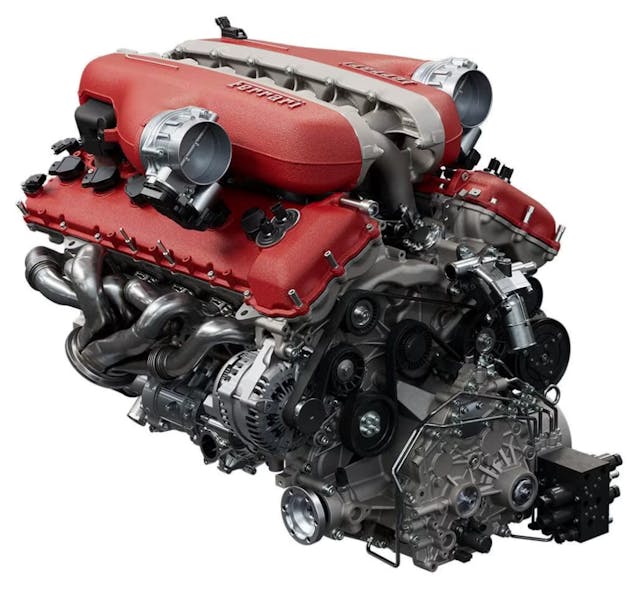
Though Ferrari has boldly experimented with and/or produced engines with two, three, four, six, eight, and 10 cylinders, it’s most associated with V-12s thanks to its loyalty to that configuration for three-quarters of a century. There’s little doubt that 12-cylinder engines have been instrumental to Ferrari winning respect as a hypercar producer. Last year, the brand built and sold 13,221 cars worldwide, reporting 19 percent increases in both volume and revenue.
Count yourself fortunate if you’ve owned, driven, or even heard more than your share of prancing horsepower!
***
Check out the Hagerty Media homepage so you don’t miss a single story, or better yet, bookmark it. To get our best stories delivered right to your inbox, subscribe to our newsletters.









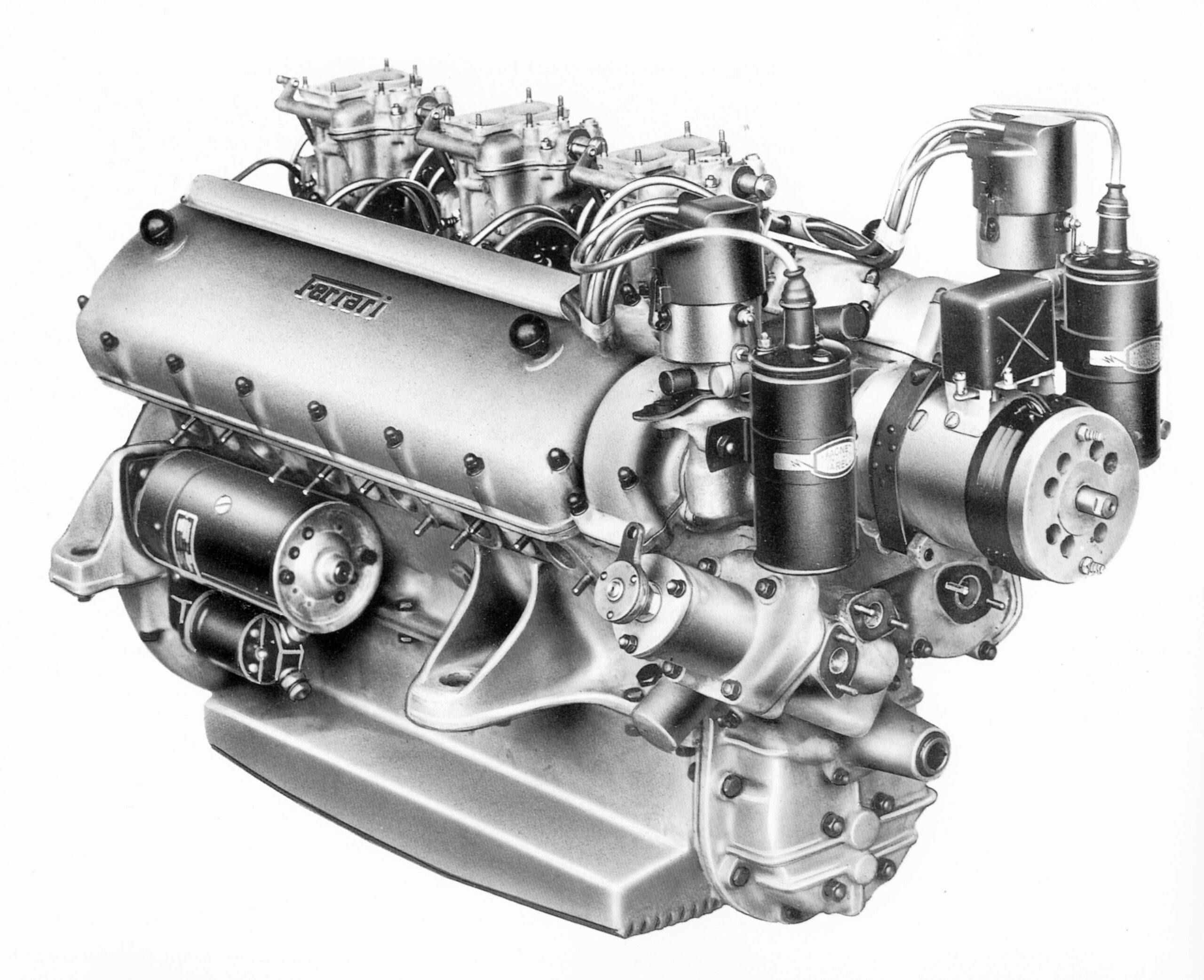












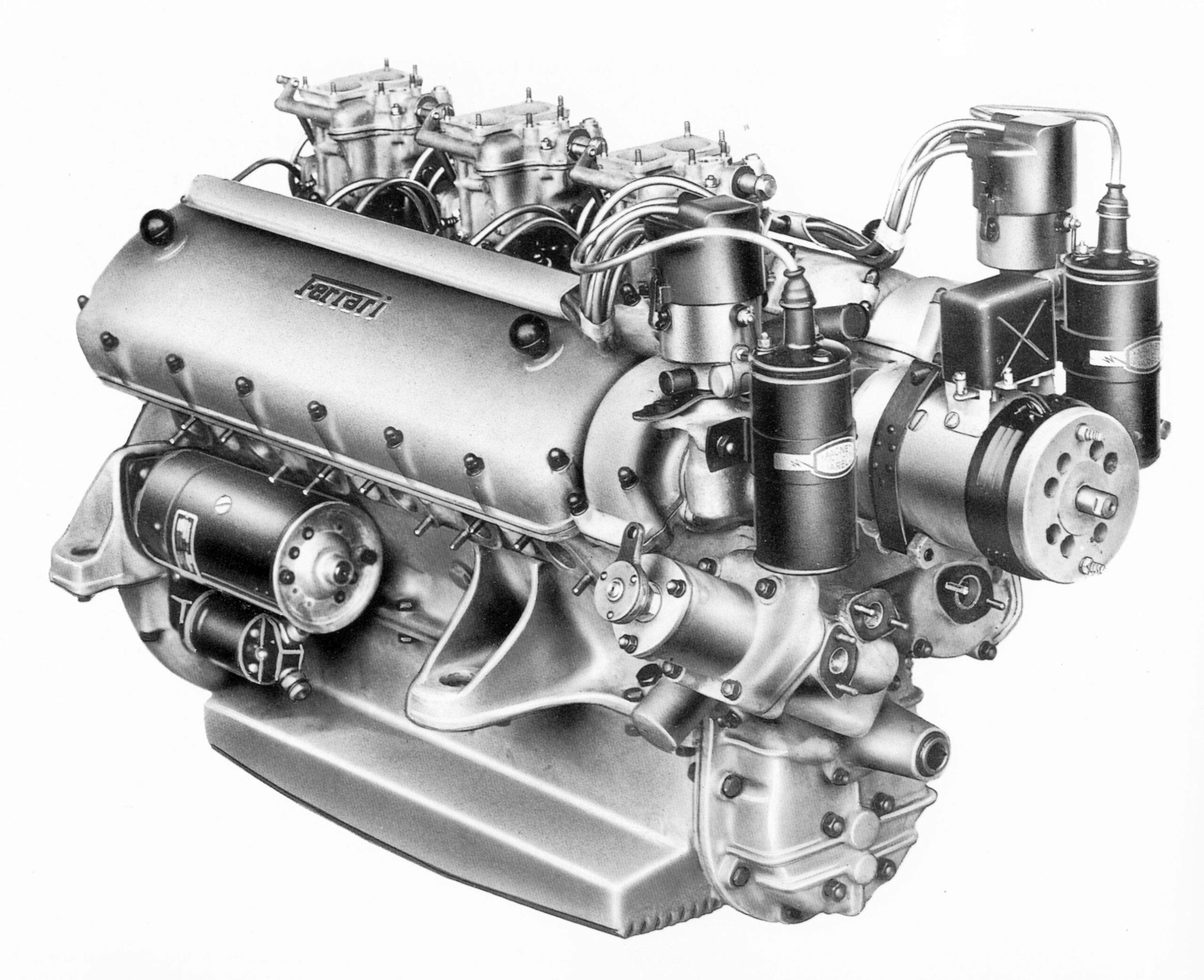


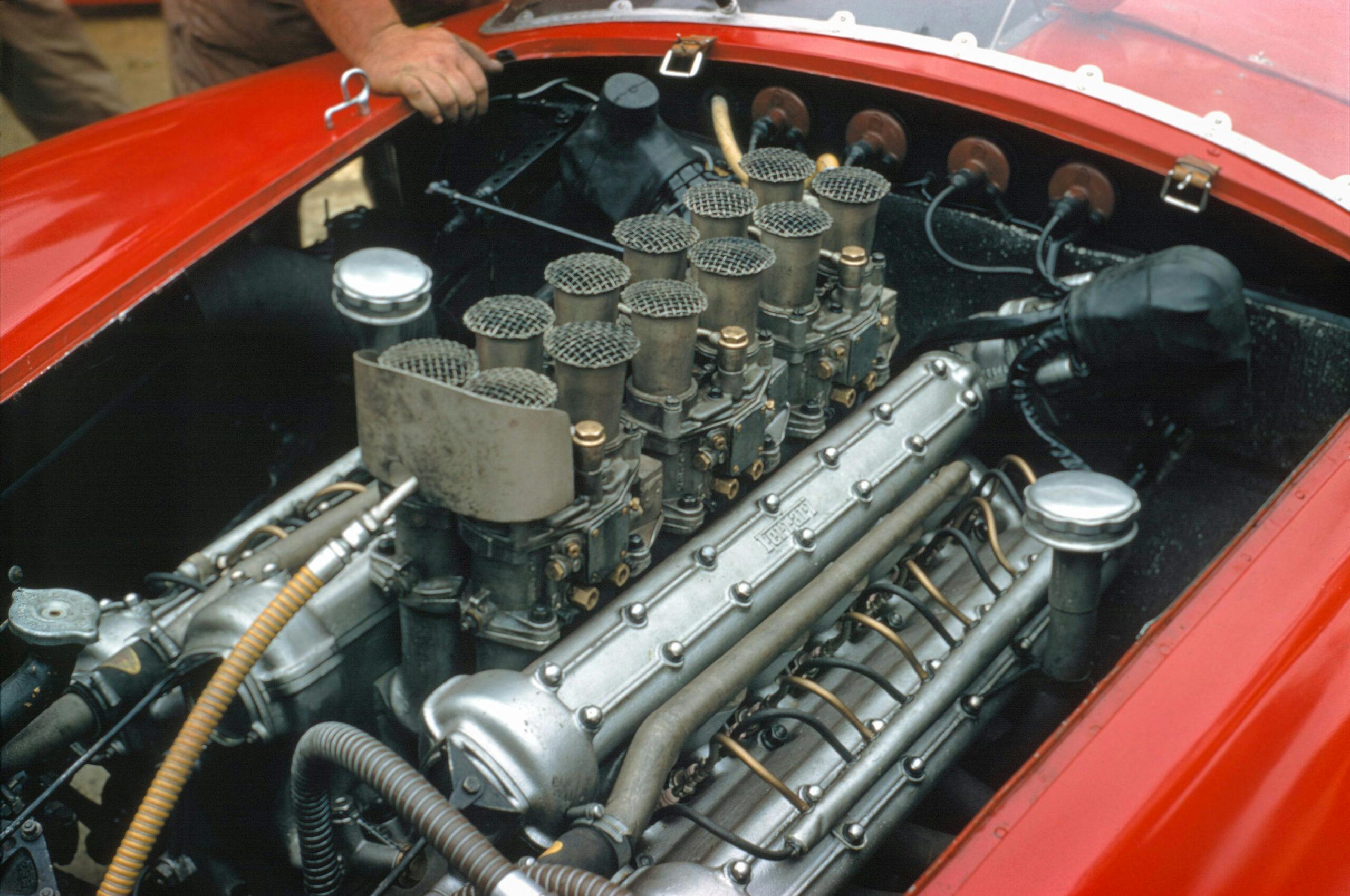
What always fascinated me were the different takes on how a V 12 was done. Just between Jaguar and Ferrari alone. The Jag has pistons the size of a Chevy but a stroke of only a couple inches. While Ferrari had pistons like my lawn tractor very small but the long stroke.
Then VW had the W12 in the Bentley.
Different strokes for different folks.
Welp, now I know what to ask Santa for…
Minor correction; famously the flat-12s were not of a boxer configuration, but rather 180 degree engines with shared crankpins for each opposing pair of cylinders. Hence, they did not produce the piston motion described, but moved in unison.
Ferrari V-12s are not under-square. Their pistons – at least on most pre-‘92 engines – just seem “lawn tractor” sized compared to the Jag’s because of their much smaller displacement, not because they have an enormous stroke.
The Ferrari V12 is a great motor. The sounds and today the power are amazing.
I did a carb overhaul of three Webbers for a V12 Ferrari tune up when I was in college in Santa Barbara in the 70s. that’s the most beautiful sounding engine I’ve ever worked on. surprisingly, easy to set the valves as well.(it was the SOHC version.) strangely enough, I recently helped a friend adjust the valves on His 1500 cc Honda Valkrie- very similar! imitation is a very sincere form of flattery…
Enzo Ferrari was not inspired by Packard’s 1915-22 Twin-Six, the auto industry’s first production V-12. According to Griff Borgeson and other historians, the wealthy young Count Felice Trossi, president of Enzo’s Alfa-Romeo racing team, “Scuderia Ferrari,” from 1932 on, long familiar with Alfas, Bugattis, S series Mercedes, able to own the best, was taken with Packard’s new 1932 V-12, called “Twin Six” that year to hark to the successful early engine, otherwise called the “Twelve” from 1933 through its final year, 1939.
(You may’ve seen Trossi’s black Mercedes SSK boat tail speedster.)
Borgeson explained: “The combination of marvelous performance, along with safety, luxury, and comfort brought about Trossi’s enduring conversion to Packard’s 1932-39 V-12. He began collecting them, buying at least two or three a year,” each custom body more lavish than the last.
The Count commuted the 171 miles between his Biella home and Scuderia Ferrari in Modena in these 1932-39 Packard Twelves. Borgeson reported “the bravura with which he drove them is legend.” These 1932-39 Packard V-12s are what inspired Enzo Ferrari. Since Packard remained a potential competitor in the international market into the 1950s with their Caribbeans, Mayfair coupes, etc., according to Borgeson, it wouldn’t do for “Ferrari to acknowledge his relatively recent indebtedness to that illustrious American marque. Hence the legend of American generals, the Baronessa Avanzo, and their vintage WWI Twin Sixes, ” which Don Sherman repeats.
Count Trossi became Italy’s Packard distributor, his ’47 Super Clipper recently for sale and on YouTube.
The two marques “commanding Ferrari’s intense interest,” continued Borgeson, “were Packard and Bugatti. If you want to know from where Ferrari drew his prancing horse imagery, recall Bugatti’s love of ‘pur sang horse flesh.'” Ettore Bugatti preferred a Packard Eight for long trips across the continent to his own products.
It’s worth remembering that only two automotive engines have natural, inherent balance: inline six and straight eight. V-12s and V-16s are the same thing with the firing impulses halved for less crankpin loading. Jaguar’s six managed to beat Ferrari five times at Le Mans in the 1950s, and it wasn’t only because of Enzo Ferrari’s stubbornness in retaining drum brakes.
I have over the years owned several V12 Ferraris – although sadly they are out of reach now – starting in 1972 with a 1966 series 2 single headlight 330GT 2+2 which cost the princely sum of £1800. I moved on via a through a 250 GTE 2+2, a 330 GTC to a 365 GT 2+2 and culminated in what I consider the prettiest Ferrari ever a 1966 275 GTB aluminium bodied, long nosed 6 carb model. At the time I owned these cars they were relatively unknown even to fellow motor traders and thus not as astronomically priced as they are today. I also owned and raced a Dino 246GT for 11 years which contrary to general belief of fragility was also virtually my daily driver. The most exciting sound wise was the 250 which would literally howl at certain revs. In England we have roundabouts and many a time I have gone circling round for multiple laps in a lowish just to enjoy the music.
Ps should read ‘lowish gear’.